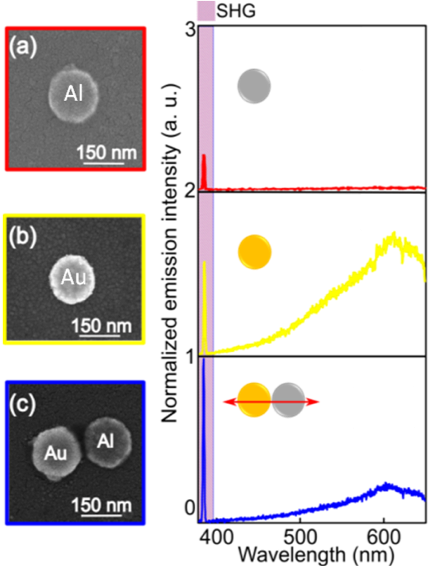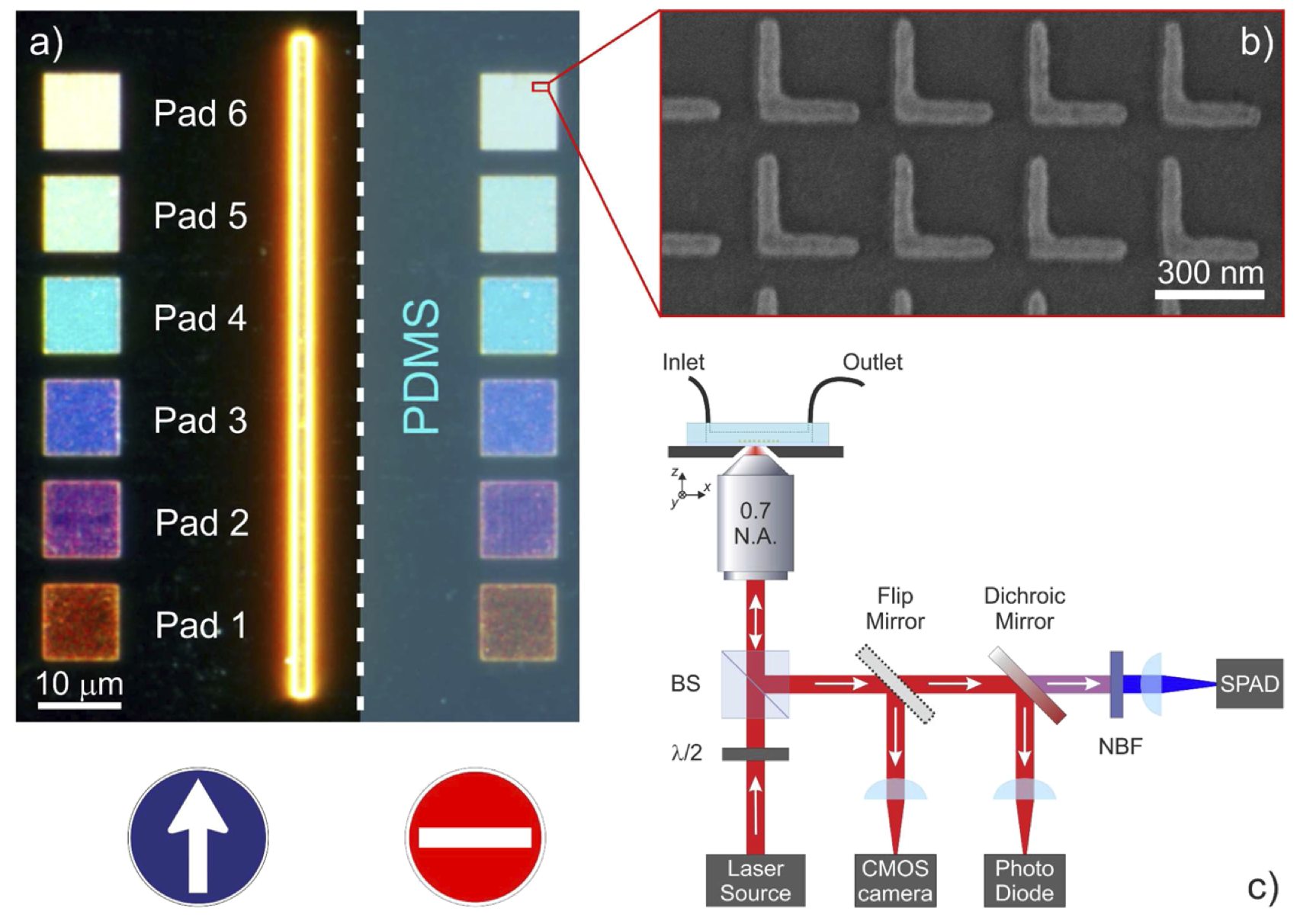In the same section
- Home
- Units
- Light, nanomaterials, nanotechnologies (L2n - CNRS-UMR 7076)
- Research topics
- Light-Matter interactions at the nanoscale
Non-linear nano-optics
Leader Scientists:
Anne-Laure Baudrion (Assist. Pr.) & Pierre-Michel Adam (Pr.)
Summary:
This project is related to the Second Harmonic Generation in metallic nanostructures, sustaining Localized Surface Plasmon Resonances. In the last years, significant efforts have been devoted to understanding the nonlinear optical processes in plasmonic nanostructures, giving rise to the research field of Nonlinear Plasmonics. It was soon established that peak SHG is achieved when the plasmonic resonances of the nanoparticles properly match the wavelengths and polarizations of either the pump beam or the SH emission. It is now recognized that efficient SHG can only be obtained in broken-symmetry configurations, which allow coupling the nonlinear local dipoles to the electric dipole modes of the nanoantennas. To this aim, strategies based on multiresonant plasmonic antennas have been proposed, where non centro-symmetric geometries of gold nanoparticles allow to enhance the local fields at both the excitation and the emission wavelength. In this context, we collaborated with different European Research groups to explore different ways to plasmonically enhance SHG.Compositional asymmetry
In the past few years, we collaborated with the Eberhard Karls University of Tübingen (Germany) to propose a strategy to take benefit of high local field and symmetry breaking by studying multi-materials heterodimers. Indeed, nanoparticle dimers are known to exhibit a strong near field inside the extremely small gap between the two plasmonically coupled single nanoobjects. We already proved that the compositional symmetry breaking of Au-Ag heterodimers is the source of higher SHG signal than the Au-Au homodimers with same dimensions [1]. Recent results we obtained on Au-Al dimers (cf. Figure on the right) tend to show even higher SHG signals. Indeed, the Au-Al heterodimer shows a higher SHG signal than the sum of individual Al and Au monomers [2]. Moreover, avalanche multiphoton photoluminescence (AMPL) is observed from coupled Au–Al nanoantennas under intense laser pumping, which shows more than one order of magnitude emission intensity enhancement and distinct spectral features compared with ordinary metallic photoluminescence [3].
Related project: BWS plus on "Light-matter interaction in the context of Core facilities"
[1] Horneber, A., Baudrion, A.-L., Adam, P.-M., Meixner, A. J., & Zhang, D. (2013). Compositional-asymmetry influenced non-linear optical processes of plasmonic nanoparticle dimers. Physical Chemistry Chemical Physics, 15(21), 8031–8034.
[2] Wang, J., Butet, J., Bernasconi, G. D., Baudrion, A.-L., Lévêque, G., Horrer, A., et al. (2019). Strong second-harmonic generation from Au–Al heterodimers. Nanoscale, 11(48), 23475–23481.
[3] Wang, J., Baudrion, A.-L., Béal, J., Horneber, A., et al. (2021). Hot carrier-mediated avalanche multiphoton photoluminescence from coupled Au–Al nanoantennas. J. Chem. Phys. 154, 074701.
Doubly-resonant gold nanoantennas

Through a collaboration with the Politecnico di Milano, in Italy, we produced arrays of doubly resonant (pump and emission) gold nanoparticles [4] and studied their sensitivity by flowing water/ethanol mixtures in microfluidic channels (cf. Figure on the right). It is worth noting that, for some arrays, the Figure Of Merit (FOM), corresponding to the SHG intensity variation normalized by the refractive index change, reached values up to 30 [5]. This sensitivity on non-optimized and non-homogeneous plasmonic particles is already larger than for most optimized linear plasmonic sensors. Further development are under progress to optimise this first SHG-sensor.
[4] Baselli, M., Baudrion, AL., Ghirardini, L. et al. (2017) Plasmon-Enhanced Second Harmonic Generation: from Individual Antennas to Extended Arrays. Plasmonics 12, 1595–1600.
[5] Ghirardini, L., Baudrion, A.-L., Monticelli, M., Petti, D., Biagioni, P., Duò, L., et al. (2018). Plasmon-Enhanced Second Harmonic Sensing. J. Phys. Chem. C, 122(21), 11475–11481.
Contact
Tel: +33325718561
Email: anne_laure.baudrion@utt.fr
Collaborations
- Monika Fleischer's group - Eberhard Karl Universität Tübingen , Germany
- Dai Zhang's group -Eberhard Karl Universität Tübingen , Germany
- Physics Department - Politecnico di Milano , Italy
- Institut Lumière Matière - Lyon, France


